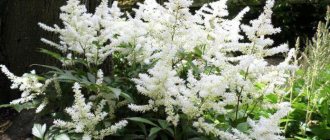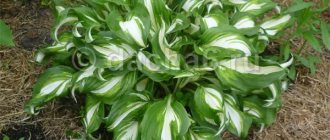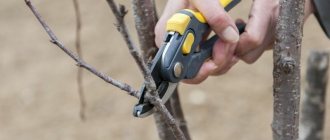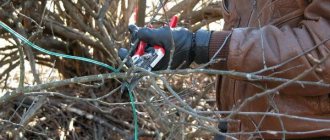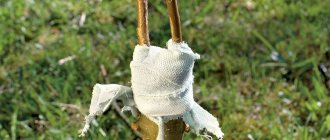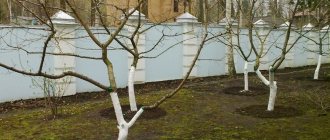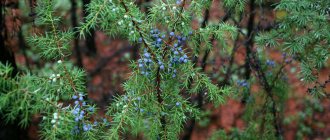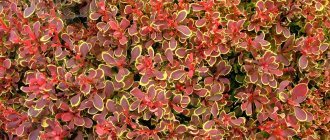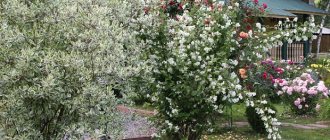Caring for garden jasmine
Garden jasmine, or mock orange, is a deciduous shrub of the Hydrangeaceae family.
This plant is often used for landscaping gardens and parks. Its numerous white flowers have a characteristic sweetish aroma. There are more than 50 types of garden jasmine and many cultivated varieties.
In the wild, mock orange is very widespread. This unpretentious shrub can be found in Europe, North America and even East Asia.
In the article you will learn everything about planting and caring for garden jasmine shrubs (mock orange), as well as about replanting and propagating the plant.
How mock orange is propagated by cuttings in the fall
Usually this shrub is propagated by cuttings, and cuttings can be rooted both in spring and autumn. The technology of these processes is not very different from each other.
Also read: Planting and growing figs in open ground in Ukraine
Rooting of garden jasmine cuttings in the fall is usually carried out in greenhouses or specially prepared cuttings. First, in the middle or end of summer, cuttings are taken from green shoots. You can also take cuttings from woody shoots, in which case they are immediately rooted in open ground. The length of the cut cuttings of this perennial should be no more than 5-6 cm, with a pair of internodes and 5-6 leaves.
Mock orange is usually propagated by cuttings
The main nuances of cutting cuttings and rooting them:
- the shoots from which cuttings will be taken should not bloom this season, and also be too thick or overgrown;
- the best shoots for cuttings are small in size, which do not bloom in a given season and have at least a couple of internodes;
- cutting is carried out with a special sharp knife, all other similar tools crush bark and wood, so they are not suitable for this type of work;
- 5 mm below the internode, the cutting is cut at an acute angle, and the upper cut must be straight (the distance from the node is at least 1.5 cm);
- the two lower leaves are removed completely, and the remaining foliage is cut off by at least half;
- in the cuttings in which future seedlings will be planted, the soil should consist of: a mixture of turf and river sand, and another layer of sand 3-4 cm thick is poured on top. Before planting, this substrate must be well watered;
- cuttings of this shrub cannot simply be stuck into the ground. First, use a thick stick to make a hole in the soil no more than 1.5 cm deep, and insert the cutting into it in a vertical position and gently squeeze the soil around it;
- plantings should be carefully watered, you can spray them, and cover the top with film or plastic bottles with a cut bottom;
- Spraying and airing of seedlings should be carried out at least once a day. In this case, they will take root faster.
Also read: Integrated control of late blight on tomatoes in a greenhouse
After 2-3 weeks, the seedlings will take root, then the cover can be removed.
The best shoots for cuttings are small in size, which do not bloom in a given season and have at least a couple of internodes
Rules for planting jasmine in the garden
To plant garden jasmine, choose an open, sunny place. This plant loves bright light, although it can also tolerate light partial shade. But with a significant lack of lighting, its shoots stretch out, it blooms sparingly, with small flowers.
Also, there should be no stagnation of water at the planting site. The proximity of groundwater is contraindicated.
Jasmine bushes can be planted in open ground in autumn and spring. But it is preferable to do this from mid-September to mid-October.
Spring planting is carried out very early, when the buds have not yet begun to bloom on the trees.
Jasmine grows well in fertile but light soil. The soil mixture for planting jasmine should have the following composition:
The components are taken in a ratio of 1:2:3.
Mock orange is planted in planting holes measuring 60x60x60 cm. A drainage layer of gravel or broken brick with a thickness of at least 15 cm is laid on the bottom. Then the hole is filled with soil mixture, the root of the seedling is immersed in it so that its root neck is at ground level. After this, add a layer of soil on top and compact it.
The planted plant is well watered. Up to 3 buckets of water are poured under each bush.
Landing in the ground
To decorate the site, select a variety that meets the purpose:
- hedge;
- lawn design;
- decoration of gazebos.
The height of jasmine varies from 1 to 3 meters. The vines grow like a grapevine. The plant feels great on a trellis or lattice terrace.
Timing
Planting jasmine in open ground is recommended in the spring when the weather is stable or in September, so that the bush, receiving appropriate care, has time to take root for the upcoming wintering.
It was noted that planting jasmine in the spring is more preferable, the likelihood of frost is reduced and there is enough time for rooting
It is important to transfer the seedling into the ground before the first leaves bloom, otherwise it is vulnerable and may die
Selecting a location
The soil where the shrub is planted needs to be well-drained, moist and moderately fertile. Jasmine needs sunlight at least 4 hours a day; with long-term light, flowering will be abundant and long-lasting. Shrubs planted in the shade develop a crown worse, the flowers are rare and small.
Each plant needs a minimum of 3 meters of space for healthy root development and crown formation for upright growers. When creating a living fence, bushes are placed every 50 cm.
Pit preparation
Before planting jasmine in spring or autumn, prepare a hole. The depth of the pothole is up to 70 cm, width up to 60 cm. A drainage layer of sand and crushed stone (20 cm) is poured onto the loose bottom. It takes several days to keep the pit in this state for it to warm up in the sun.
When planting jasmine, the roots are covered with soil, which includes:
- peat;
- ash;
- humus;
- black soil;
- sand.
The process of planting a seedling
The crucial moment on which the future state of jasmine depends must be carefully prepared:
- The prepared earthen mixture is poured into the dug hole to form a mound.
- Inspect the root system of the seedling. Dry, damaged shoots are removed with pruning shears.
- The roots are laid out on the surface of the ground and buried. The root collar is at ground level; it is unacceptable to lower it into the ground more than 3 cm.
- Add soil and compact the hole.
- Water with water at the rate of 2 buckets of water per bush.
- Sprinkle with mulch to retain moisture and prevent weed growth. Use pine needles, peat or sawdust.
Basics of caring for garden jasmine
Jasmine grows well in moist soil and does not like it to dry out. There is no need to water it in spring and autumn. But in the summer heat its leaves often wither. To prevent this from happening, the plant must be watered regularly. Watering 1-2 times a week is enough for normal growth of the bush.
If mock orange grows in a humid, low-lying area, excess water can cause it to become diseased. Therefore, in such places, watering of plants is limited. Even in hot summers, water no more than 2 times a month.
Adult garden jasmine bushes are fed three times a season. In mid-spring, organic fertilizers are added to the soil. The plant responds well to watering with slurry. Manure is diluted with water in a ratio of 1:10 and the bush is watered.
At the beginning of summer, the plant is watered with a solution containing:
- 15 g urea;
- 30 g superphosphate;
- 15 g of potassium sulfate.
These components are diluted in 10 liters of water.
After flowering, fertilize with a solution of superphosphate and potassium sulfate. Take 15 g of each substance and dissolve it in 10 liters of water.
The soil around the jasmine bush is loosened at least 2 times a season. It is best to do this 2-3 days after watering. To retain maximum moisture in the soil, it is recommended to mulch the loosened soil with a layer of sawdust or peat.
CHUBUSHNIK (Garden jasmine): planting and care in open ground! + PHOTO
We tell you the rules for planting and caring for mock orange in open ground. We describe in detail when and how best to plant garden jasmine.
We consider caring for plants in the garden: watering, fertilizing, pruning, flowering, preparing for winter, as well as diseases and pests.
Which is correct: mock orange or garden jasmine?
Mock orange belongs to the Hydrangeaceae family, and jasmine belongs to the Olive family. At the same time, the shrubs are quite similar to each other, especially in their sweet and strong aroma, which is why confusion arises.
In Russia and the CIS countries, mock orange is often called garden jasmine, but real jasmine is a heat-loving plant (subtropical zone) and freezes out in harsh climates. Some of its species are successfully grown at home or in greenhouses (Indian, sambac, etc.).
Our planting rules and tips for caring for outdoors are intended for mock orange or, popularly, “garden jasmine.”
- These names are used in the article as synonymous words, since these names hide the same plant.
In Russian gardens, the most commonly grown mock orange (ordinary), virgin, hybrid winter-hardy varieties of mock orange Lemoine and selection of Vekhov Nikolai Kuzmich.
Chubushnik "Snow Storm"
Chubushnik: planting in open ground
For the excellent development and flowering of a plant, the planting location, soil and soil mixture, planting distance and planting depth play an important role.
This is a kind of foundation that provides comfortable conditions for growing mock orange in open ground for the next 25-35 years.
Landing location
The plant is best suited to a quiet place, which should be well lit, especially in the first half of the day, but light partial shade at noon is also allowed. It is best to plant mock orange on the south, southeast and southwest sides.
Garden jasmine can grow in the shade, but in this case the flowering will be much weaker, it will stretch out and take on a less beautiful appearance.
Do not plant shrubs in places where rain or melt water accumulates, or where groundwater lies closer than 150 cm from the surface of the earth.
Soil and acidity
Mock orange loves fertile soil with high air and moisture permeability. Light and medium loamy soils rich in humus are well suited to it. At the same time, garden jasmine can grow in poor soil, but then the development and flowering of the bush will be weaker.
Heavy clay soils are not suitable; in this case, more powerful drainage and a “lighter” soil mixture are required. On sandy loam soils, on the contrary, you can do without drainage, and it is better to replace part of the sand with garden soil.
The optimal soil acidity level for mock orange is pH 6.5-7.5 (close to neutral reaction).
Soil mixture
Substrate options for garden jasmine.
- Leaf soil, humus, turf (garden) soil, peat in equal parts is a universal option.
- Turf (garden) soil, humus (compost) and sand – 3:2:1. Well suited for clay soils and black soil.
- Humus, black soil – 1:1. Preferred option for sandy soils.
- It is advisable to add one glass of wood ash or two tablespoons of superphosphate to any soil substrate.
Landing distance
Large shrubs and trees - 2.5-3 m. When planting mock orange in groups, the distance depends on its type, approximately 80-140 cm. If you want to make a hedge of garden jasmine then - 60-80 cm, the place should be well lit.
Mock orange hedge
Planting depth
When planting, the root collar of the seedling should be located approximately at ground level. The maximum depth is 2-3 cm, otherwise there is a high risk of rot development.
How to plant garden jasmine correctly? Instructions
- Dig a planting hole: depth and width - 50-60 cm. At the bottom of the hole, make a 10-15 cm drainage layer of crushed stone, gravel or sand.
- Add some potting mix. Place the seedling in the center of the hole so that the base of the bush is approximately at ground level.
- Gradually fill the planting hole with soil mixture and compact it so that there are no voids.
- Trim all shoots to about 30% of their length (a couple of buds to a strong bud). Water the seedling in the tree trunk circle with 10-15 liters of water. Place a 3-4 cm layer of peat, bark or sawdust on top to keep the root ball moist longer.
Rules and tips
- Plant mock orange in cloudy weather or in the evening to help it establish better.
- It is advisable to dig the planting hole and fill it with soil mixture 3-4 weeks before planting.
- If the seedling has damaged roots, remove them and treat the cut with charcoal powder.
When is it better to plant mock orange in spring or autumn?
Garden jasmine is best planted in spring (April) or autumn (September - October).
A seedling with an open root system can only be planted in the spring before the leaves bloom, otherwise it will die, and in the fall from September 10 to October 15. Seedlings in containers can be planted throughout the growing season.
These dates for planting mock orange are also suitable for gardeners in the Moscow region, Leningrad region, the Urals and Siberia.
Mock orange seedling in a container for planting in open ground
Mock orange transplant
The garden jasmine bush is relatively easy to transplant at any age. The optimal time for transplanting adult bushes is from late August to mid-October, but it is also possible in the spring in April.
- The day before digging, water the mock orange abundantly so that it is easier to move with a lump of earth, and it will stock up on nutrients.
- Trim young shoots of the current year (autumn) or last year's by 30-40% (spring).
- Carefully dig up the bush, plant it together with a lump of earth in a new place and water it with 10-15 liters of water.
Chubushnik: care in open ground in spring, summer and autumn
The shrub is quite unpretentious in care, drought-resistant and resistant to adverse external factors.
However, to obtain maximum decorative value from garden jasmine, it is necessary to properly care for it.
Watering
Moisture is of great importance for mock orange. If it is deficient, the bush may not bloom. Water garden jasmine regularly, especially in hot and dry weather, to prevent the leaves of the bush from drooping (loss of turgor).
The maximum moisture requirement is from April to July, when the bush is actively growing, preparing for flowering and blooming. During this time, water approximately every 7-12 days with 15-30 liters of water.
We recommend reading: “WHAT IS THE BEST WATER TO WATER PLANTS?”
In the spring, before flowering begins, it is advisable to spray the bush with warm and soft water. For young plants, it is useful to add growth stimulants to the water (Zircon, Epin Extra and others).
After the first watering in the spring, mulch the tree trunk circle with a 3-4 cm layer of peat to retain moisture in the soil.
Loosening the soil
During spring and summer it is necessary to loosen the soil 2-4 times to a depth of 4-6 cm. Also remove weeds in a timely manner - they take away macro- and microelements from the mock orange.
Feeding and fertilizers
For the first two years after planting, mock orange does not need to be fed with mineral fertilizers. Garden jasmine needs additional nutrients for abundant and lush flowering.
- In early April (before the leaves bloom), dissolve 15 grams of carbamide (urea), 15 grams of potassium sulfate and 30 grams of superphosphate in 10 liters of water and water the bush. Or water the plant with mullein infusion - 1:10.
- After 3-4 weeks (beginning - mid-May), repeat feeding.
- Immediately after flowering, scatter 20-25 grams of superphosphate (1 tablespoon) and 10-15 grams of potassium sulfate per 1 m2 over the surface of the ground.
2nd option
- Before flowering (late April - early May), scatter two tablespoons of nitrophoska and a glass of wood ash over the surface.
- During flowering and immediately after it, water with the solution: 20-25 grams of superphosphate (1 tablespoon) and 10-15 grams of potassium per 10 liters of water.
Adviсe
Instead of mineral fertilizers, wood ash can be used during and after flowering. To do this, pour a glass of ash with 10 liters of water and leave for two days, and then pour the bush into the tree trunk circle.
Bloom
The maximum attractiveness of garden jasmine appears when the fragrant flowers open. It is for its pleasant, sweet and powerful aroma that most gardeners love it.
The smell of mock orange has a beneficial effect on the human psyche and improves mood. The plant usually blooms in the 3rd year after planting.
Mock orange flowering time
The flowering period of garden jasmine depends on its type and variety. In the conditions of the Moscow region, the first to bloom is the crown mock orange and garden forms based on it: golden (aureus), dwarf and variegated. They bloom almost immediately after the common lilac (beginning of June).
In the first two weeks of June, small-leaved mock orange, thin-leaved, and Schrenk's mock orange bloom. In early - mid-July, the odorless, grayish, broad-leaved and fluffy mock orange begins to bloom (it blooms later than all others).
The average flowering time is 20-25 days, a little longer in a shady place. Schrenk's mock orange blooms the longest, and, for example, Gordon's mock orange is able to bloom a second time in the fall.
Chubushnik "Zoya Kosmodemyanskaya"
Why doesn't mock orange bloom? What to do?
Garden jasmine may not bloom in some situations. The most common reasons: lack of lighting (grows in the shade), lack of moisture or nutrients (watering, fertilizing), unsuccessful wintering (freezing of annual shoots), excessive pruning in the spring or too deep planting.
Perhaps the mock orange does not bloom due to its age, especially if you grew it from seeds (7-8 years) or from cuttings (4-5 years).
Proper pruning of mock orange: in spring, after flowering, in autumn
Garden jasmine needs annual pruning to form a decorative crown shape, especially vigorous species and varieties. Otherwise, it will become thickened with young shoots and grow unsightly.
Sanitary pruning in spring
Before the buds awaken (late March - early April), remove weak and damaged shoots growing inside the bush. If desired, you can trim back some of the strongest branches, but be careful as over-pruning may result in no flowering this year.
Sanitary pruning can be carried out at any time of the year. You will complete the full formation of the crown of the bush after the mock orange has flowered.
Anti-aging pruning
Approximately once every 2-4 years it is necessary to rejuvenate the plant. Early in the garden jasmine, cut off all shoots older than 10-12 years at the very base of the bush (“to the stump”).
Due to such pruning, the crown of garden jasmine will be rejuvenated and powerful flowering and growth will be stimulated. New strong shoots will bloom next summer.
"Updating" an old bush
It is easier to rejuvenate a very old or neglected bush by radical pruning.
- At the end of April, cut down all the trunks at ground level, and cut the 3-4 healthiest ones at a height of 35-40 cm. Treat the cut areas with garden varnish, and spread a 4-5 cm layer of humus around the bush and dig up the soil a little (6-8 cm) .
- In the summer, water the mock orange regularly and abundantly. It is also advisable to feed with mullein infusion 1-2 times.
- In the fall, new shoots will appear from dormant buds, but in the spring, 3-4 of the strongest ones will need to be left and the rest completely removed. These most developed shoots are the basis of the young bush.
Formative pruning of mock orange after flowering
Formative pruning of garden jasmine is best done immediately after flowering (mid-June) so as not to disturb flowering, since it blooms on last year's shoots.
- First, remove all faded inflorescences. If you did not prune in the spring or there is a need, then remove all weak and damaged branches entirely.
- Then trim the current year's shoots back to last year's growth (the green part of the branch to the woody part).
By October, new growth will have appeared on these branches with side shoots on which flowers will appear next spring. If you want to reduce the height of the bush, then trim all or the longest shoots below the growth zone. - Also prune 4-5 year old shoots growing inside the bush and bare, weakly flowering shoots to thin it out. And if the bush has become very thick, then cut off 20-25% of the old trunks at the base.
Pruning mock orange in autumn
You cannot prune young shoots of garden jasmine in the fall if you want it to bloom next year. In the fall, if necessary, you can carry out sanitary pruning and thinning of the bush (inward growing and weak shoots).
Preparing mock orange for winter
Most plant varieties are distinguished by good winter hardiness, especially domestic selection. Adult mock orange bushes do not need winter shelter, and specimens up to 2 years old should be mulched with a 4-5 cm layer of peat or pine needles.
If the tops of annual shoots of an adult garden jasmine freeze in winter, it will still bloom, and with the help of pruning in the spring it is easy to restore the crown of the bush.
In the conditions of the Moscow region, Leningrad region, Siberia and the Urals, it is better to plant winter-hardy varieties.
Pests and diseases
Mock orange is rarely affected by pests or diseases, but it is important to regularly inspect the bush for their presence.
The most common pests are weevils, mealybugs, spider mites, aphids, scale insects and false scale insects. Aphids are especially common on young leaves of shoots.
Interesting to know
You can make honey from mock orange nectar. This honey improves sleep, helps relieve fatigue and headaches.
The plant got its name because of the structural features of the stems from which mouthpieces and pipe stems were made.
ADDITIONS TO THE ARTICLE:
1. WHAT IS THE BEST PROPERTIES TO PROPAGATE MOUNT NUMBER? + VIDEO
2. POPULAR MOUNT VARIETIES WITH PHOTOS – REVIEW!
3. HOW TO CARE FOR JASMINE AT HOME?
We wish you successful planting, easy care of the mock orange in the garden, and enjoy its wonderful flowering!
flowersholiday.com
Bush formation and pruning
To preserve the decorative appearance of the bush and maintain lush flowering, annual formative pruning of the plant is carried out. This is done in early spring, while the buds have not yet bloomed.
When forming the crown, all branches older than 10 years that practically no longer grow must be removed. They are cut at ground level. All dry, thin and elongated shoots are also cut out. All branches are left until they are 4 years old and shortened slightly. This stimulates branching and promotes the growth of buds.
Very old bushes with bare trunks can be given a decorative look. To do this, rejuvenating pruning of the plant is carried out in early spring. It is also useful to rejuvenate bushes that were severely damaged during the winter cold.
To rejuvenate jasmine, leave 5-6 of the strongest branches 3-4 years old. They will be the basis of the new bush. The remaining branches are removed, cutting at the root. The branches left behind are greatly shortened. They are cut to a length of 35-40 cm. All cuts must be covered with garden varnish. Over the summer, many new shoots grow on the abandoned branches.
Next spring, rejuvenating pruning is continued . Shoots are cut out on each of the main branches, leaving 3-4 of the strongest ones, which are shortened slightly. During the summer, they form a lush bush, which will bloom the next year.
Why pruning a bush?
Jasmine is grown for its intense fragrance in the garden and its beautiful, delicate flowers. Pruning jasmine in spring has several goals:
- improve the appearance of the plant;
- heal and rejuvenate the bush;
- extend the flowering period;
- increase the number of inflorescences and their size.
Removing long branches of jasmine helps create symmetry or create the desired shape. Heavily overgrown bushes are thinned out to produce young, strong shoots. The ends of branches about 40 cm long are cut off, or removed completely at ground level. Shoots older than 10 years must be cut off.
After pruning jasmine, the sections must be sealed with garden varnish to maintain the health of the bush.
Growing a plant in the garden requires regular care; jasmine is regularly freed from old inflorescences and unnecessary shoots. After winter, cut off frozen branches and roots on the surface of the earth.
Formative pruning of jasmine in the spring will prepare the plant for the flowering period and increase the number of young shoots, which will give it fullness and hide the bare trunks. In the spring, before the plant “wake up,” pruners are used to cut off the old branches flush with the ground or shorten them by a third of their length.
Pruning jasmine in the spring will give shape to the plant, remove weak and shorten branches that are too long, and allow you to get new shoots that will increase the splendor of the bush.
Over time, the “older” the plant becomes, the more “wild” shoots appear, which do not bear any load, but are actively fed from the roots. This greatly affects the aesthetics and health of the plant. In spring or autumn, remove unnecessary branches and thin out the inner space of the bush.
Features of jasmine pruning:
- The initial “haircut” of jasmine is carried out 3 years after planting in a permanent place.
- Spring work begins before the buds appear.
- Two-year-old shoots are not touched; they are responsible for the development of the root system, the formation of the crown and the production of flower beds.
- To obtain a beautiful and high-quality crown, maintain a bush height of about 2 meters.
- When pruning, dry, diseased, crooked shoots and branches older than three years without flowering buds are removed first.
- Bushes seven years old and older need pruning for rejuvenation. Healthy and strong trunks (1/3) up to half a meter high are left, the rest are removed at the root, sealed with garden varnish. This provides sunlight and stimulates the growth of new branches. Next year, one third of the remaining old trunks are cut off; by the end of the third year, pruning of the old branches should be completed.
- The shoots coming from the ground away from the bush are cut off; they are not suitable for forming a plant.
Preparing for winter
Mature jasmine bushes are quite frost-resistant. When grown in the temperate climate of our country, there is no need to cover them for the winter.
Sometimes, during particularly harsh winters, the tops of the youngest shoots of jasmine freeze. Then, during spring pruning of the bush, it is necessary to remove the damaged parts. This does not in any way affect the further development of the plant and its flowering.
Young plants may not tolerate severe frosts, so they must be carefully prepared for winter . In the fall, before the first frost, the soil around the bush is dug up and covered with a thick layer of mulch.
This prevents the plant's roots from freezing. Its ground part is wrapped with covering material and secured with rope so that the shelter is not blown away by the wind. Such preparation is quite sufficient for the successful wintering of all young bushes, even those planted in the fall and not yet able to take root well.
Autumn feeding of mock orange
Usually, the last feeding of garden jasmine is carried out after flowering has ended - this happens in the summer. But you can also feed the bush in the fall - either before pruning, or two weeks after it, so that the bushes have time to recover after removing the shoots.
For this last feeding, you should use 15 tablespoons of superphosphate and 1 tablespoon of potassium sulfate (or any other potassium salt) per 1 m2, or add 1 cup of wood ash.
These mineral fertilizers accelerate the ripening of young shoots, restore the strength of perennial shrubs after abundant flowering, and also allow the root system to gain strength to become more resistant to the approaching cold weather.
Methods for propagating jasmine
Let's look at how the jasmine bush reproduces. Garden jasmine is propagated:
- Seeds;
- By cuttings;
- By layering;
- Dividing the bush.
Sowing seeds is the most difficult method of propagation. It is very labor intensive and requires a long time to obtain flowering specimens. Also, bushes of the desired variety do not always grow from seeds. Therefore, in garden culture, easier and faster methods of propagating jasmine are used.
A simple way to propagate jasmine bushes is by cuttings.
Mock orange is easily propagated by green cuttings with a heel , which are cut in mid-summer.
They are treated with a root formation stimulator and dropped into containers filled with a moistened mixture of humus, peat and sand.
Reproduction
You can grow jasmine from seeds, layering and cuttings.
It is ineffective to plant jasmine seeds in the ground if you are trying to get a sea of fragrant flowers on the bush. Flowering is possible only after 7 years. It is easier to use the layering technique, in which a full-fledged specimen is obtained with a high degree of probability.
Propagating jasmine by cuttings in the spring is the most popular way to start a new plant, which does not require human energy. Cut off the side shoots with inflorescences, shorten them to 5 cm, but make sure that the branch has at least two internodes and two pairs of leaves.
For planting and subsequent care, you can get roots from a cutting of garden jasmine by keeping it in settled water for about 2 weeks, or in a sand-peat mixture. The cuttings are buried into the soil at an angle, then covered with plastic containers or polyethylene to maintain constant humidity and temperature.
To develop the root system, regularly water and loosen the soil. At the end of summer, a new specimen of jasmine will be ready, which will be planted in a permanent place in the fall.
Before propagating jasmine bushes, look at photos of different varieties. It may make sense to plant and care for other species on the site, which will differ in the size of the flowers, color and height of the bush.
Pests and diseases and their treatment
Garden jasmine is very rarely affected by harmful insects. Of all the pests of garden plants, aphids and red spider mites can live and reproduce on it.
Aphids attack young shoots of jasmine and often breed on them in large numbers. It feeds on plant sap, which causes the youngest leaves to curl and dry out. If appropriate measures are not taken, the bush will stop growing and will not bloom.
Spider mites are very small harmful representatives of arachnids. Feeding on the sap of the plant, it settles on the underside of the leaves. It is not easy to detect, but its presence is revealed by cobwebs on the tops of shoots and the underside of leaf blades.
To completely destroy pests, it is necessary to treat the plant with insecticidal preparations. They are used twice, with a break between treatments of 7-10 days.
Garden jasmine is very resistant to various diseases. Only sometimes it is affected by root rot. But this only happens due to errors in caring for the plant and the wrong choice of planting site.
Root rot occurs when there is excess moisture in the soil . This can happen due to overwatering or when planting the bush in a wetland. In the first case, the bush should be watered less, and in the second, it should be urgently transplanted to a new location.
Transplanting mock orange to a new place in the fall
One of the important positive qualities of this perennial shrub is its rapid adaptation after planting or replanting. This shrub can be replanted at any time, except when the jasmine is blooming. If mock orange is replanted in early spring, flowers will appear on it only in the next season.
The nuances of transplanting this shrub:
- you need to pour a large amount of water into the tree trunk circle (at least two to three buckets) so that you can easily dig it up along with a lump of earth;
- While the moisture is absorbed, you need to carry out sanitary pruning - remove all damaged branches, as well as old ones, shorten young shoots by one third;
- and only then the bush is dug up and transferred to a new hole.
Before planting, at least 20 liters of water are poured into the prepared hole, then the bush is placed and covered with a nutrient mixture. The tree trunk circle should be sprinkled with mulch on top (humus can be used).
Jasmine bush in the landscape
Now let's see how to plant jasmine beautifully in the garden. Garden jasmine is often used in landscape design due to its variety of shapes, leaf colors and abundant flowering. It looks great in single, group and border plantings. A large number of its varieties allows you to choose plants to decorate your garden in any style.
For single planting, plants with an architectural crown are used. The “Virginal” variety is distinguished by a spreading, dense crown, dotted with large double flowers during flowering.
The bush of the Snow Storm variety looks just as beautiful. On its drooping branches during flowering, almost no leaves are visible. The flowers are white and medium in size. The variety forms large inflorescences of up to 15 flowers.
In group plantings, plants with different crown shapes and flowering periods are used. The variegated forms of this shrub, such as “Variegata” and “Aureus,” look interesting.
Jasmine is often combined with various flowering garden shrubs: hydrangea, viburnum or turf to create unusual landscape compositions.
To grow hedges, tall varieties with a massive crown and medium-sized varieties of mock orange are used.
For border plantings, the shortest and most compact varieties with a height of less than 1 m are used. Now you know how to care for jasmine in the garden.
You can learn about growing jasmine at home here.
Did you like the article? Share it with your friends on social networks:
Types of Jasmine
Wild mock orange will melt in Eurasia and America. This is a resident of temperate latitudes. About 70 species grow on both continents, about 30 have been introduced into cultivation. All of them are deciduous shrubs. The number of varieties is much larger - several hundred.
Mock orange is called jasmine because its flowers look and smell similar to indoor jasmine. This is where the similarity between mock orange and real jasmine ends. Genuine jasmine is a heat-loving evergreen shrub that grows in tropical climates. Chubushnik is a deciduous inhabitant of temperate latitudes.
Advantages of mock orange:
- hardy;
- withstands urban conditions - gas pollution, infrequent watering;
- frost-resistant;
- grows on any soil;
- withstands haircuts;
- can be used to create borders and hedges.
Jasmine can be almost odorless, but the vast majority of varieties fill the air with an intoxicating aroma when they bloom. There are varieties with the smell of bird cherry, acacia, and fruit.
Types of mock orange:
- Variegated - a rare cultivated species with multi-colored plates.
- Common or pale - loves moist soils. The leaves are bright green above and faded below, with pubescence on the blades.
- Coronet is a shrub up to 3 m high with cream and white flowers, collected in inflorescences of 7-9 pieces.
- Lemoine is a shrub with ovate lanceolate leaves, used in decorative landscaping more often than other species. Many of its varieties have been developed.
- Caucasian - grows wild in the Caucasus, height up to 3 meters. In gardens it grows up to the latitude of St. Petersburg. It tolerates pruning and the harmful effects of smoke and gases.
- Large-flowered - brought from North America. The flowers are odorless. More heat-loving than other species, but tolerates shade better.
Common mock orange and crown marigold can grow in very cold climates. They tolerate frosts down to -40. In Russia, gardeners and landscapers more often plant hybrids of mock orange and small-leaved mock orange.
Popular varieties:
- Chamomile - a low-growing bush strewn with single flowers with long petals;
- Yunnat - blooms with stars up to 6 cm in diameter with a strong strawberry scent;
- Ballet of moths - greenish semi-double flowers resemble butterflies;
- Arctic - blooms with small snow-white stars;
- Pearl is a small bush with huge (up to 7.5 cm) flowers that hang like beads.
How to transplant jasmine to another place
Jasmine is a crop that is very popular among gardeners. Jasmine owes this popularity, first of all, to the beautiful flowers and wonderful aroma that it presents during flowering. In addition, it is quite unpretentious to weather conditions and is quite easy to care for. There are many garden varieties of this plant. Its flowers come in mostly white, yellow and pink colors. In addition to garden varieties of the crop, there are also indoor varieties that are grown at home. Sometimes it is also compared to the jasmine-like mock orange plant.
The need to replant jasmine may arise for various reasons, for example, garden trees block access to sunlight, and it is necessary to move it to a sunnier place, or there is a need to redesign the arrangement of plants in the garden plot. Still, it is better to think about the location of the jasmine in advance before it is planted.
Choosing a suitable landing site
These species and varieties can be found in many gardens and summer cottages. As a rule, garden jasmine is planted in open ground in the spring. In order for the plant to grow and develop normally, you need to know several important rules for both planting and caring for it. As a rule, planting different types and varieties of garden jasmine is practically no different.
Key points in choosing a suitable landing site:
- When choosing a suitable place on the site for this plant, you should definitely take into account the fact that it can adapt to almost any weather conditions. However, if you want your plant to have a spectacular appearance and bloom very profusely, then it should be planted in a place that is protected from strong drafts. The fact is that they have an extremely negative effect on this shrub. Also, garden jasmine grows and develops better in a well-lit place with enough direct sunlight.
- This shrub is recommended to be planted in close proximity to flowers that have a purple or deep blue color tint. For example, it will look great next to delphinium or lavender. Jasmine also grows well next to hydrangea or spirea.
- Experts advise planting garden jasmine in the spring. However, this procedure can be carried out in the fall.
Transplantation process
Preparation
Before transplanting jasmine, you should consider the following factors:
- Season. The most suitable periods for replanting jasmine are autumn or spring. When it is most effective to replant jasmine, in spring or autumn, different gardeners have different opinions. If it is in the spring, then you need to guess the time when active sap flow has not yet begun (April). If you replant jasmine in the fall, then this should be done at the moment when the plant has already slightly renewed its supply of nutrients after flowering. Usually this is the first half or mid-October. The remaining months are not suitable for replanting jasmine. It is not recommended to replant jasmine in summer.
- New place. You should make sure that the new place where the plant will be transplanted is well lit. In addition, jasmine does not really like soil with a high water layer.
Important! How well the plant will take root and how beautiful it will become depends on the correct choice of place for replanting jasmine.
- Plant age. If there is an assumption that jasmine may need to be replanted in the future, then it is better to do it earlier, because the older the plant, the more difficult and longer it will take to recover after replanting. If, when transplanted, for example, in the Moscow region, a 7-8 year old plant simply takes a long time to recover, then in a colder climate it may even die.
Transfer
Before you start transplanting, you must first prepare a new place:
- To do this, dig a hole. Its diameter, as well as its depth, should be enough to easily accommodate the root system of the bush; it is advisable to make it even a little larger.
- Fertilizers must be placed in the prepared hole. To do this, you need to use rotted manure or highly diluted mullein (in a ratio of approximately 1:15). It can be mixed with soil. In addition, you need to add superphosphate or wood ash (about 2 handfuls).
- Pour a bucket of water with the root into the hole and let it soak for about 30 minutes.
Transplanting seedlings in autumn
Transplanting a seedling in the diagram
Experienced gardeners say that replanting an apple tree in the fall has a beneficial effect on its development and fruiting. There are different opinions regarding other fruit trees. Transplantation of seedlings is carried out as follows:
- 2 months before planting, prepare holes 70-100 cm deep (depending on the crop). Their diameter should easily accommodate a lump of soil.
- When preparing the hole, separate the top fertile layer of soil.
- Place peat, humus, and rotted manure at the bottom and mix them with previously prepared black soil.
- Water the planting site with water.
- The roots of the seedling are placed in a hole, covered with earth, and compacted.
- After planting, watering is done again.
Young fruit trees are replanted with a soil ball and bare roots. It is better to choose two-year-old plants. The grafted shoot must have at least 4 living buds. Leaves must be removed before digging, as they impair survival rate. Container seedlings (the root system is closed and located in a special container) take root faster than others
It is important not to water the plant in containers before planting, so as not to disturb the soil lump.
Plant care
Top dressing
For fertilizing, both mineral and organic fertilizers should be used.
Mineral fertilizers can be a solution of superphosphate in the following ratio: 10 liters of water, 30 g of superphosphate, 15 g of urea and 15 g of potassium sulfide. This solution can be applied around the beginning of May. After flowering, it is also recommended to feed the jasmine with potassium and superphosphate.
Organic fertilizers should be applied to the soil once a year. For this, manure is used, diluted with water in a ratio of no less than 1:10.
Watering and loosening
Watering jasmine should not be done too often. On average, twice a week will be enough. During the flowering period, it is advisable to try to water the bush every day. It is recommended to loosen the soil several times a season so that oxygen and moisture can better penetrate to the roots.
Pest protection
Jasmine is a plant that is little susceptible to harmful insects and microorganisms. It is most often exposed to aphids and spider mites. Aphids mostly attack young shoots and leaves. It actively reproduces on them and drinks the juice, which leads to the leaves drying out and curling.
Jasmine is most often exposed to aphids and spider mites
Spider mites are difficult to notice on leaves, but they are revealed by cobwebs on the underside of the leaf or on shoots. They, like aphids, feed on plant sap.
You can protect yourself from both of these pests with the help of insecticides. Treatment should be carried out twice, with a break of 7-10 days.
In addition, in some cases, this crop may be affected by root rot. To get rid of it, you need to take care to reduce the humidity. To do this, you need to either reduce the amount of watering, or, if the problem is in the wrong place, replant the bush.
The need for a transplant may arise for various reasons. However, it should be performed if there is reason to believe that it will bring more benefit than harm, because this procedure is always painful to varying degrees.
Scheme and timing of pruning mock orange in the fall
Typically, the main pruning of mock orange is carried out in early spring, when the buds on the shoots have not yet begun to swell. At the same time, all frozen branches are removed to healthy wood, and formative pruning of the crown is also carried out to give the shrub the correct shape. But thinning the bushes, as well as sanitary pruning of the bushes, should only be done in the fall.
It is in the autumn period that the bushes are thinned out, which promotes the active growth of new shoots, which in the next season will actively increase the vegetative mass, and will also be covered with beautiful flowers with a pleasant aroma.
After the end of flowering (still in the middle of summer), all old shoots that are more than 5 years old should be cut out, and already a few weeks before the onset of cold weather, all damaged, dried or broken shoots should be removed. But the side shoots that have grown during the season should not be actively cut out - after all, the buds will appear on them next season.
Experienced flower growers say that if you do not prune this perennial annually, then in a couple of years the bush will lose its decorative shape and will practically not bloom.
In the autumn, thinning of chubushnka is carried out, which promotes the active growth of new shoots
Is it possible to replant jasmine in the fall?
Ornamental shrubs are traditionally favorites of gardeners and landscape designers. Their popularity is understandable, because such a simple solution as planting jasmine , with the arrival of spring, will turn the summer cottage into a magical corner where it is pleasant to work and relax, enjoying the wonderful beauty and magical aroma of the numerous flowers strewn throughout the vast bush. Its scientific name is not very euphonious and is used mainly in official sources. The bush is popularly known as garden jasmine. He received this name from German gardeners through the shape and smell of his flowers.
Mock orange shelter for the winter
Mock orange is highly frost-resistant, so it does not need shelter for the winter. The only thing that can be done is to add a layer of mulch up to 15-20 cm thick to the tree trunk of the garden jasmine in late autumn (two weeks before frost) to prevent freezing of the perennial root system. Peat, humus or rotted leaves (or straw) can be used as mulching material.
Also read: What can you plant tomatoes next to: choosing neighbors in the garden
Mock orange is highly frost-resistant, so it does not need shelter for the winter.
Jasmine - selecting the optimal site
Nature has endowed the shrub with high resistance to adverse environmental influences. It is shade-tolerant, can grow in nutrient-poor soil, and tolerates arid climates well. However, one should not expect high decorativeness from it in such conditions. Growing jasmine in heavily shaded areas will cause the bush to become elongated and produce few flowers. Poverty and dry soil will slow down its development, and the leaves and buds will be small.
Open sunny areas with well-moistened soil, which contains a lot of humus, are preferred for mock orange. The shrub will bloom beautifully and luxuriantly in the countryside and in partial shade, but only if it is insignificant and falls from the side. You can plant it in light to medium loams.
The best soil for garden jasmine is made from the following components: • 3 parts leaf soil, • 2 parts humus; • 1 part river sand.
The bush does not tolerate stagnation of water in the soil, so it requires good drainage. It will be provided by a thick layer (at least 15 cm) of pebbles, gravel, expanded clay, broken brick or crushed stone poured onto the bottom of the planting pit. Heat-loving varieties of jasmine are sensitive to drafts, so they should be placed in areas protected from cold winds.
General transplant rules
To carefully pull a plant out of a pot without damaging it, you must first water it thoroughly, let it settle for a little while, and then carefully free the root ball from the ground.
You can use a stick or knife, it is important not to touch the spine. . When replanting completely, the entire lump of old soil is removed from the root system.
When replanting completely, the entire lump of old soil is removed from the root system.
You need to add fresh soil directly to the pot. It is necessary to lay drainage at the bottom to drain water after watering. It allows you to smooth out small miscalculations during overflow. Drainage can be expanded clay, pieces of brick or shards. Many flowers experience stress after transplantation, but in general they tolerate this procedure normally.
There are 3 types of transplantation:
- Complete transplant. When it is necessary to replace all the soil, it is imperative to clear the root of the old soil.
- Partial transplantation. With this type of replanting, the roots are not disturbed; the soil around the roots is replaced.
- Replacing the top layer. If the flower was originally in a large pot, then replanting should not be carried out; in this case, the top (old) layer of soil should be replaced every spring. This type of transplantation is suitable when it is necessary to replace the old layer of soil with a new one.
Jasmine - planting secrets
Jasmine bushes are planted in the garden in spring or autumn. Usually the plant is propagated by cuttings, digging holes about 50 cm deep for them. It is important that the soil covers only the root of the seedling, and its trunk remains completely on the surface, otherwise it may rot. Experienced gardeners recommend planting shrubs in the country in the fall. It is better to choose a warm, clear day for the procedure from the second ten days of September to October 10. If jasmine is placed in the soil in the spring, then in order for it to take root well and not die, you need to plant it before the shrub produces leaves.
Is it possible to replant jasmine?
The need for replanting arises when you need to move the jasmine bush to a more illuminated place, or in order to free up space for planting other plants. Also, changing the location helps renew the bush. However, only those jasmine bushes that have not reached the age of seven can be replanted . The fact is that the younger the bush, the better it takes root in a new place. An adult plant does not tolerate the traumatic replanting procedure well and may not take root at all. In this case, even high-quality care will be useless, and the jasmine will most likely die.
Jasmine - care rules
Caring for garden jasmine bushes will not take much time. When its flowering is over, the jasmine is carefully examined and faded buds and weak branches are removed. Be sure to also trim dry, damaged shoots directed inward to the crown. This will provide an incentive for the development of new, strong shoots. In the fall they will begin to branch, and next spring their young shoots will be covered with flowers. When 3 years have passed since the mock orange took root in the open ground, the bush is rid of old branches, pruning them to the base of the trunk without regret. Thanks to this, young and vigorous shoots will have more free space for development, and their flowering will be more luxuriant.
To grow jasmine successfully, the bush must be properly watered and fed. High air and soil humidity are important for mock orange. Throughout the growing season it needs frequent and abundant watering. Use settled soft water for it. To prevent moisture from being retained in the ground, but rather being absorbed by the roots of the plant, watering is carried out with warm water. The shrub responds well to spraying, but during flowering it is contraindicated. In the first year, garden jasmine will only need the fertilizers that were added to the soil during planting, and then it needs to be fed regularly. Complex mineral preparations intended for flowering shrubs are suitable for jasmine.
You can prepare the nutritional composition yourself by dissolving 3 ingredients in 10 liters of water: • superphosphate (30 g); • urea (15 g); • potassium sulphide (15 g).
For organic fertilizers, it is recommended to use slurry, apple or birch ash. At the beginning of autumn, jasmine is fed with humus or compost at the rate of 2 buckets per 1 adult bush, placing it in the soil at a shallow depth. Growing jasmine is also not complete without regular weeding and loosening of the soil. You can mulch the soil around its trunk with peat, dry compost, and leaf humus. This will help retain moisture and improve the passage of air to the roots of the plant. The mulch layer should be 4-7 cm.
Jasmine - reproduction features
The shrub is propagated in various ways: • by seeds; • cuttings; • shoots; • root layering; • dividing the bush.
When planting garden jasmine seeds, you will have to be patient. They are sown at the beginning of winter, on the eve of severe cold weather. You can do this even in the snow. Having deepened the seeds into the soil, they are covered with spruce branches. Shoots appear in early spring. The seedlings turn out to be hardened, but it will take 7-8 years to reach the state of an adult plant, when the bush can bloom. The most common method used is to grow jasmine from layering. In order for the bush to produce them, with the onset of spring, all shoots are removed from it, making room for young and full of vigor shoots. To propagate garden jasmine, choose strong branches. They are bent to the soil, enclosed in previously dug grooves. The shoots are deepened into the ground, sprinkled with sand and peat on top. After 1.5 months they will begin to branch, and in the fall the young bush can be separated from the mother bush and replanted.
It is even easier to propagate garden jasmine from cuttings. They are obtained from strong shoots by pruning the bush in June. The optimal cutting length is 5 cm. They are rooted in a light and food-grade mixture of peat and sand, placed shallowly in it at an angle of 30-40 °. Then the container is covered with film, or preferably glass, and placed in a well-lit place. Petioles require daily care in the form of spraying. When they take root, they can be planted in open ground, covered with a plastic cup in the first days.
Exquisite jasmine, planting and caring for which is not difficult, will effectively decorate any summer cottage. It looks good in single plantings, as part of hedges, and in combination with other shrubs. Its delicate flowers will fill the evening garden with a wonderful aroma. They can also be used to make bouquets.
Even inexperienced gardeners can cope with growing unassuming jasmine. It is frost-resistant, rarely affected by pests and diseases, does not require replanting, and tolerates heat and drought patiently. All you have to do is place the shrub in a sunny corner, regularly water it, trim it and occasionally feed it, and you can admire its spreading dense crown and lush flowering for a long time, while you yourself play for money here klubvulkanonline.com
Replanting jasmine in autumn
From time to time, jasmine has to be transplanted to a new place.
The need for replanting can arise for a variety of reasons - to make room for other plants, to renew a bush, to move it to a brighter place, or who knows what else. When and how is it best to do this? Any plant is easier to transplant at a young age. When planting jasmine in the garden, plan in advance where and what trees and shrubs should be located, so as not to injure them later by replanting. Jasmine bushes older than 7-8 years may not take root at all in a new place, and if the need already arises, try to carry out the procedure at an early age.
The best time to transplant jasmine is autumn - early or mid-October. In summer, during flowering, plants are not replanted at all. And after it, the bush will need three months to recuperate and accumulate nutrients. Otherwise, it will not take root and will die.
Some of the shoots are removed so that the bush is not too dense. It is easier for a light shrub to take root in a new place. The remaining branches are tied together with a rope. Now you need to water the ground generously, the soil should completely soften, this will require 5-6 buckets of water. Roots are removed from soft soil without damage. Water is poured gradually - 1-2 buckets at a time, as it is absorbed, add more and more.
Now our task is to carefully dig up the roots, dig the shovel down, retreating 30 cm from the trunk. They dig up the bush from all sides, cutting off small roots, shake off the soil with their hands, and remove the bush from the ground.
The hole in the new location should already be ready, its size should be slightly larger than the volume of the root system. Place manure, superphosphates, 2 handfuls of wood ash, and soil from the top layer at the bottom of the hole and mix everything. Then a bucket of water is poured into the hole, with the root dissolved in it, and after it has been absorbed a little, the plant is placed and sprinkled with soil. The root circle is watered and sprinkled with mulch made from pine needles, sawdust or shavings. The rope is removed.
When choosing a place for jasmine, remember that soil with stagnant water and high groundwater levels is not the best place for it. Although in general jasmine is unpretentious to the soil, it develops and blooms well on fertile black soil.
Sometimes gardeners allow jasmine to be transplanted in the spring, before the buds open and the sap begins to flow. This could be March-April, depending on the weather and climate. All stages of work are carried out in the same way as during autumn transplantation, with the exception of one thing - the shoots are cut off completely, leaving stumps up to 30-40 cm high. New branches will grow in a new place, but flowers are unlikely to appear on them this year.
Favorite shrubs for the garden: planting mock orange and caring for it
A white veil of flowers shimmering in the moonlight, and an intoxicating aroma pouring into the room through the open window - a picture of a rural summer familiar from childhood. For Russian ornamental gardening, planting mock orange and caring for it is as common as growing lilacs. True, it is popularly known under a different name - jasmine, which has become so popular that it is often used even by professional landscape designers.
History of the plant
The mock orange plant has been known since ancient times. For example, in Ancient Greece, craftsmen made pipes for smoking pipes from hollow stems of bushes. This is where its name comes from.
But many people wonder why mock orange is called jasmine? The answer is very simple - because of the striking similarity in the aromas of the flowers of these two beautiful plants. However, unlike mock orange, jasmine is most often grown indoors.
Almost all varieties of mock orange are quite unpretentious to the environment, and feel great both under the scorching sun and in the shade, and can easily tolerate frosty winters.
Therefore, they can be found almost all over the world: in North America, Europe, East Asia, and North Africa.
How the bush blooms
Jasmine blooms annually and profusely, filling the pause after spring flower beds before the opening of summer flowers. It is valued along with roses and irises for its decorative value. In May-June, the garden jasmine shrub is fabulously beautiful. At the end of the young shoots, numerous flowers open, behind which almost no foliage is visible.
Mock orange flowers are single or collected in racemes. They are simple and double, the petals are wide and narrow. Most varieties have snow-white flowers, but some have two-tone colors. A novelty in floriculture are varieties with fully colored petals. Mock orange is a good honey plant that attracts pollinating insects to the garden.
The flowering period depends on the type and variety. Plants generally bloom in the first month of summer. The most interesting varieties are those with double flowers, variegated leaves and dwarf forms.
Description of the plant
Mock orange jasmine can be easily distinguished from a variety of flowering shrubs by its special structure. It reaches a height of about 4 meters, its stems are brown with a brown tint and cracked bark. Jasmine leaves are pale green in color and quite large in size, and when autumn comes, they take on a colorful lemon yellow color. The flowers of this massive shrub are cream or white in color, collected in raceme-shaped inflorescences. The size of the flowers is no more than 5 cm in diameter. As usual, the mock orange bush begins to bloom very profusely from late spring to mid-summer, although the flowering period depends on the variety of jasmine. The photo shows a blooming jasmine.
Development problems and pests of mock orange
Among the many advantages of mock orange is its resistance to diseases and those few pests that are nevertheless tempted by it. Inexperienced gardeners often misdiagnose problems caused by lack of care, mistakenly considering them to be a manifestation of a particular disease.
Care problems
Most of the reasons why mock orange does not bloom lie precisely in the area of care. There are several of them:
- the plant fattens because it is overfed with nitrogen;
- the bush does not have enough light, and we are not talking about light partial shade, but a truly shaded place;
- the bush was pruned too much in the spring, and it threw its energy into restoration;
- pruned late in the summer - the young shoots did not have time to set flower buds (blooms weakly).
Moisture deficiency is the main reason why mock orange leaves curl. During the dry period, the shrub requires abundant watering - 30-40 liters per bush every 2-3 days, and even more often during flowering - it is necessary that the soil does not dry out. Dry autumn is a reason to do moisture-charging watering for the winter.
Mock orange diseases
Fungal diseases affect mock oranges extremely rarely, and their best treatment is to eliminate the causes, as can be seen in the photo below - thickening and waterlogging. Regular pruning promotes free air exchange in the crown area, protecting the foliage from rust and spotting. To destroy pathogenic microflora, spraying with fungicides is recommended.
Pests
Rainy summer favors the spread of pests - leaf weevils that suck the juices of leaves, bean aphids that colonize the tops of shoots, and spider mites that pose a threat to young growth.
Aphids on mock orange are the most real threat; how to deal with them is determined based on the degree of damage to the bush. The few colonies on the tops are removed mechanically or washed off by dissolving a piece of laundry soap in warm water. If this does not help, spray the bush with an infusion of tobacco dust (10 g/l), mustard powder (20 g/l). Treatment of the plant with an insecticide gives a 100% effect.
If you are passionate about ornamental gardening, mock orange will sooner or later find its way into your garden. And once it arrives, it will conquer your heart forever, making you fall in love with the delicate fragrance of fragrant petals.
